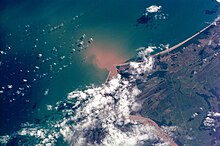Doce River
| Doce River | |
|---|---|

Doce River delta at the Atlantic Ocean.
|
|
| Native name | Rio Doce |
| Country | Brazil |
| Basin features | |
| River mouth | 19°39′21″S 39°48′53″W / 19.6558°S 39.8148°WCoordinates: 19°39′21″S 39°48′53″W / 19.6558°S 39.8148°W |
The Doce River (literally the "sweet river"; Portuguese: Rio Doce [ˈʁiu ˈdos(i)]) is a river in southeast Brazil with a length of 853 kilometres (530 mi). The river basin is economically important. In 2015 the collapse of a dam released highly contaminated water from mining into the river causing an ecological disaster.
The Doce River is formed by the junction of the Piranga and the Carmo near the historical city of Ouro Preto, whose sources are located in the foothills of the Mantiqueira and Espinhaço mountain chains at altitudes of about 1,200 m. It flows in a northeastern direction via Ipatinga, makes a wide curve near Governador Valadares, and flows in a southeastern direction passing through Conselheiro Pena, to enter the Atlantic Ocean near Linhares in Espírito Santo state. Its main tributaries are the Piracicaba, Casca, Matipó, Caratinga-Cuieté, Manhuaçu, Santo Antônio and Suaçuí Grande, in Minas Gerais; the Pancas, Guandu, and São José, in Espírito Santo.
Part of the river basin is contained in the 3,562 hectares (8,800 acres) Augusto Ruschi Biological Reserve, a fully protected area. South of the point where the Piracicaba enters the river near Ipatinga the river forms the eastern boundary of the Rio Doce State Park.
The Doce river has great economic importance for the region. The basin is home to the largest steel making complex in Latin America. Three of the five largest companies in Minas Gerais state in the year 2000, Companhia Siderúrgica Belgo Mineira, Arcelor Mittal (Acesita) and Usiminas, are located there. The largest open-pit mine in the world is operated in the basin by the Companhia Vale do Rio Doce. These industrial conglomerates have an important role in Brazilian exports of iron ore, steel, and cellulose (Cenibra). In addition, the Doce basin contributes greatly to production of coffee from Minas Gerais and Espírito Santo as well as fruit pulp from Espírito Santo.
...
Wikipedia

